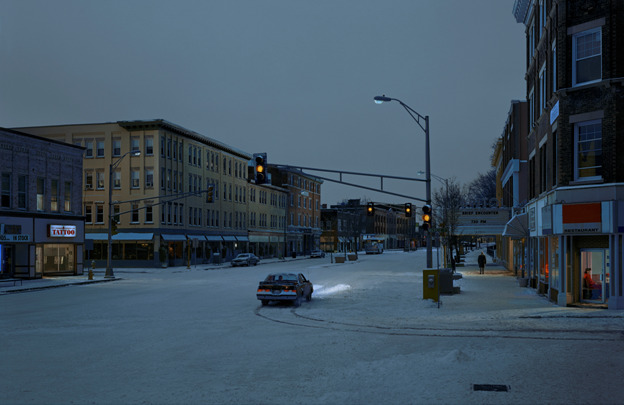Gregory Crewdson: Brief Encounters
reviewed by Jae Matthews
In what may be the most ambitious individual production of his photo series Beneath the Roses, the artist Gregory Crewdson stares at the heel of a man being placed in the scene. The devastated, yet nondescript Main Street of Somewhere, Anywhere, Nowhere America, has been closed to traffic and as an additional blessing the street has been covered in a proper mid-winter snowfall. Crewdson makes a slight adjustment to the actor’s leg and then retreats, only stopping again some five feet away to look again at that leg. The artist is fixated, but moves on— the leg must do.
What Ben Shapiro gives his audience in his documentary, Gregory Crewdson: Brief Encounters (2012), is a delicate portrait of an artist’s attempt to capture fleeting “moments” through painstaking orchestration. The film follows Gregory Crewdson for roughly five years as the photographer develops his series Beneath the Roses, a project once conceived as a film. Crewdson’s photographs are cinematic in quality and evocative in content, yet the scope of the production flies on Icarus’s wings, costing enough to fund a small film and embracing all the trappings of film work: a cinematographer, an art director and a devoted crew. Yet, the notable photographer does not embody any hubris or even suggestion of such–just a need to create his entangled moments, absent memories he shares with folks like you and me.
The documentary does not try to explain Crewdson’s work, but merely attempts to follow the process of its production. The structure of the film appreciates the remnants of Gregory Crewdson’s intentions: No photo has a definitive message, but merely speaks to a feeling, a melancholy. Through interviews with the artist, and various others (notably Rick Moody and Russell Banks, writers who deal with similar terrain), a likeness of the artist develops: he speaks about his drive, his psychoanalyst father, his need for preservation. But the most striking segments of the film are the ones where Shapiro follows the artist, and documents the meticulous process of these photographs. The audience then is privy to Crewdson’s obsessive micro managing; he is tangled up in every element of the photograph. Smartly, Shapiro stays away from the obvious, but lets the film chase the photographer – this is not a question and answer type of movie.
In the film, Crewdson says that he is fascinated by the “dynamic between beauty and sadness,” a compulsion that is explicit in his photographs. His landscapes all exist in this empty terrain of streetlights, gloomy skies and empty lots, or motel rooms or dead-end streets. Nowhere places. Although different physically, all the spaces share the same haunt: something that once was, a mere recollection. And, his characters: The faces he finds are shaded by life, their bodies still, almost struck by a quiet despair, much like he states in the documentary, they are “at the moment between moments.” Shapiro captures a telling segment of Crewdson’s intentions as he films the photographer staring at a woman’s face: she asks him if she should look down and he says yes, but with a slight sense of regret. Even his characters’ emotions live in this liminal realm of being, yet not quite having–the formless smoke between reality and artifice.
Gregory Crewdson’s work suggests disconnect and yearning between its subject and photographer. Yet this remains the key to the work: an inexplicable sadness. Ben Shapiro gives his audience some insight into the photographer’s personal life, but not much, which is rewarding, as there is no need to really embellish the world around Crewdson. His photographs are enough. The documentary touches upon Crewdson’s youth, his psychologist father, his rock and roll band, and his early work, but the fundamental exploration is that of childhood vacations in western Massachusetts, where Crewdson as a photographer continues to return. This landscape of nostalgia inspires his haunted portraits of American life and suggests a cyclical connection to what was once vital, but is now muted, almost forgotten.
Published December 3, 2012.
Jae Matthews was born in Upstate New York to a retired preacher and a civil servant. She attended SUNY-Purchase Film Conservatory for her B.F.A. in Film Production, and journeyed all the way down to Georgia for an M.F.A. in the same sport at the Savannah College of Art and Design. Jae is currently studying for an additional degree in Cinema Studies and trying to acquire a Southern accent. Her interests lie in sexuality, representation, and class culture.

